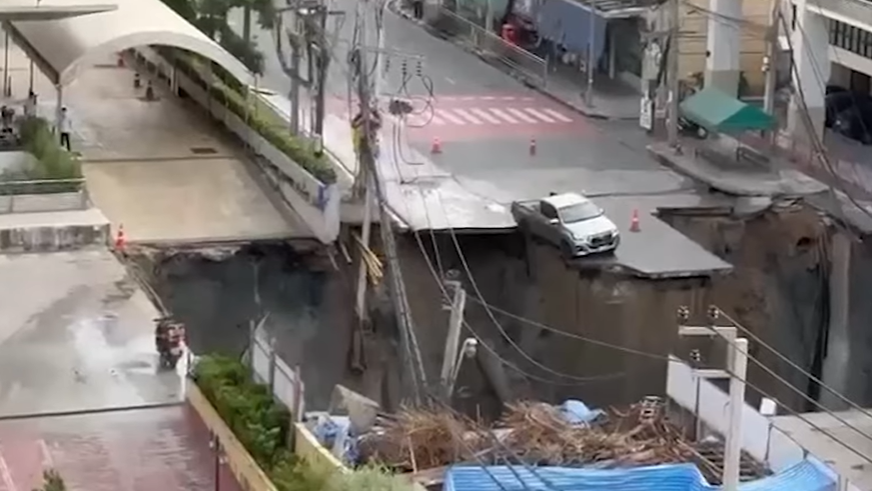In a dramatic early-morning collapse on September 24, 2025, a vast sinkhole tore open along Samsen Road in Bangkok’s Dusit district, just outside the gates of Vajira Hospital. The fissure, estimated at nearly 30 × 30 meters across and plunging around 50 meters deep, swallowed three vehicles, pulled down electricity poles, and ruptured underground pipes. Miraculously, no injuries or fatalities have been confirmed. Yet the impact was immediate: traffic was halted, utilities cut, and nearby facilities evacuated.
Eyewitnesses described the ground sinking gradually at first, then catastrophically, dragging cars toward the void. The crisis demanded swift, coordinated action from authorities across municipal, health, police, and infrastructure agencies.
Officials Point to Subway Work, Water Rupture, and Soil Instability

From the outset, Thai leaders and city officials offered blunt assessments of what led to the collapse. “Dirt from an underground train construction was sliding in,” declared Prime Minister Anutin Charnvirakul in remarks to reporters, adding, “Luckily there are no deaths or injuries.”
Bangkok Governor Chadchart Sittipunt elaborated on the cascading failures: “A pipe had burst so water and power lines have also been cut.” He acknowledged that while the hospital remained structurally sound, nearby areas were at high risk. “The hospital has no problems, but we are worried about the police station: that’s still dangerous and the public has been evacuated,” he said.
In a video posted later by the governor, he described how shifting soil above a tunnel joint and the failure of support led to collapse: “Once the land slipped into that tunnel, then the whole tunnel collapsed. It also burst a pipe and the water made everything collapse further.”
Analysts say the collapse appears to have arisen from the intersection of three stressors: active underground construction (particularly subway tunneling), a burst drainage or water main undermining soil support, and the saturation of Bangkok’s soft soils during monsoon season. As the road gave way, water from the ruptured pipe is believed to have accelerated erosion beneath the surface, pulling even more soil into cavities and causing a runaway effect.
Evacuations, Shutdowns, and Stabilization Efforts Underway
Once the scale of the collapse became clear, authorities acted swiftly. Outpatient services at Vajira Hospital were suspended, and staff and patients were relocated while the hospital building was declared safe from immediate structural risk.
Buildings next to the crater—including the adjacent police station—were evacuated. The public was barred from entering the zone, and a safety perimeter was established.
Electricity and water supplies in the vicinity were shut off to avoid hazards and further pipeline damage. Engineers began placing monitoring instruments around the sinkhole during daylight hours to detect shifting ground, cracks, or further subsidence. By midday, officials reported that further ground movement had been halted and that stabilization efforts would continue throughout the night.
Repair crews and geotechnical teams are now assessing how to shore up the crater’s walls, back-fill the void, and reconstruct utilities while preventing renewed collapse. Meanwhile, alternate traffic routes around central Bangkok are being enforced to reduce congestion and maintain city connectivity.
Deeper Risks, Urban Growth, and Infrastructure Lessons
The incident has shone a glaring light on the fragility beneath Bangkok’s bustling surface. The simultaneous expansion of underground infrastructure, aging subsurface plumbing, and heavy seasonal rains have made urban land subsidence and sinkhole risks more acute than ever.
What unfolded today suggests that even well-engineered subway works can undermine stability if water leakage or soil softening is not rigorously managed. As Governor Chadchart noted, once the soil slipped into that tunnel, “the whole tunnel collapsed”; the rupture of one pipe may have unlocked a chain reaction.
For Bangkok, this event may catalyze more stringent oversight of subterranean construction, better mapping of under-road utilities, and continuous subsurface monitoring. Public safety now hinges not just on response, but on prevention.

Hi, I’m Andrew, and I come from India. Experienced content specialist with a passion for writing. My forte includes health and wellness, Travel, Animals, and Nature. A nature nomad, I am obsessed with mountains and love high-altitude trekking. I have been on several Himalayan treks in India including the Everest Base Camp in Nepal, a profound experience.



